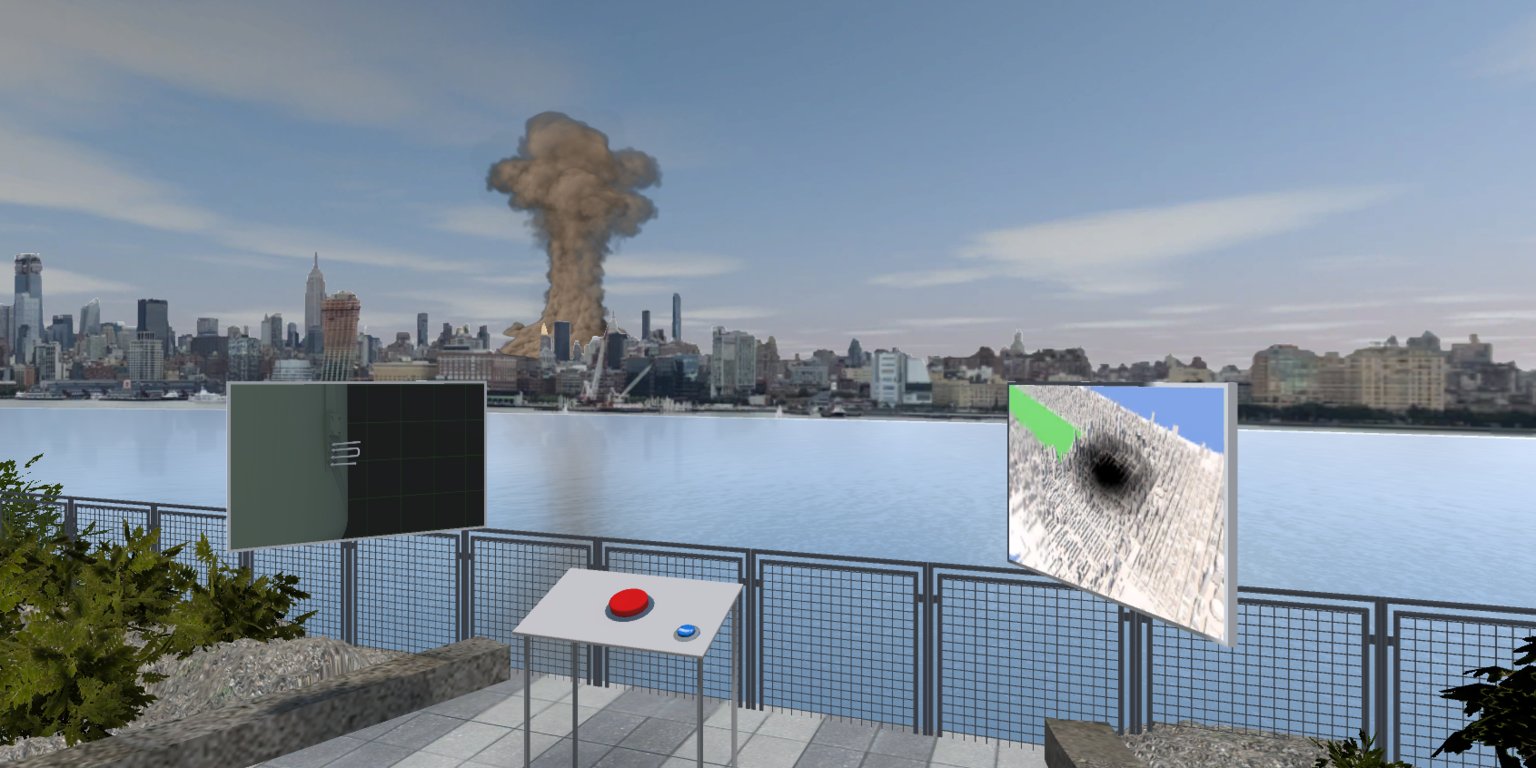Try it: stand on Babbio Patio, face the skyline of Manhattan, and look at it, the colorful, discordant mixture of skyscrapers that line the horizon — get in your oohs and aahs — before you imagine Times Square, in an instant, decimated by a W-80 nuclear cruise missile.
What does the explosion look like in your mind — a mushroom cloud, a fog of smoke? Can you even see it since the flash from the nuclear blast blinded you? After all, such a weapon, which is currently in U.S. arsenals, has 10 times more explosive yield than the “Little Boy” bomb dropped on Hiroshima. Did the sound wave, so great that it could deafen you immediately, knock you over? In that moment, did you know what to do next, how to stay safe, how to potentially save yourself from a slow, radioactive death?
These questions might seem impossible to answer. But soon, they’ll be easier. Assistant Professor of Visual Arts and Technology Christopher Manzione and Alex Wellerstein, historian of nuclear weapons and Assistant Professor of Science, Technology & Society, demonstrated a new project, Nukemap VR, at a recent exposition on nuclear risk. This tool lets users, wearing virtual reality goggles, detonate a bomb in Midtown Manhattan and see what a nuclear explosion would actually look like from the view of Babbio Patio.
Theirs is one of 15 projects managed by Reinventing Civil Defense, a $500,000 project at Stevens Institute of Technology that aims to “restore a broad, cultural understanding of nuclear risk.” Wellerstein and Assistant Professor Kristyn Karl are co-PIs on the project, which is funded by the Carnegie Corporation of New York.
Reinventing Civil Defense comes at a crucial time for Americans, when, according to some experts, risk of nuclear attack is the highest it’s been in decades. Around the world, there are nearly 15,000 nuclear weapons held and 1,800 metric tons of usable nuclear materials stored. Any minute now, daily life could change drastically, and experts believe protecting people from disaster requires every person to understand how real nuclear risk is — but many do not.
“The elimination of nuclear risk from the lived experience of Americans has relegated nuclear issues into a near mythical realm, one that has led to both fatalism and apathy,” write Karl and Wellerstein on the project website. “Talk of possible nuclear terrorism often falls on deaf ears outside of expert and activist circles, and it inspires no practical action. As a result, it is very difficult to convince the broader public to support policy efforts and similarly difficult to foster interest that might lead to the next generation of talented arms-control practitioners.”
Inflaming concern for nuclear policy requires researchers to tap into people’s emotions, whether fear, wonder, or curiosity. Often it is emotion, not fact, that inspires people to take action. For a student at Stevens, seeing a bomb go off in the city with Nukemap VR might empower them to ask important questions they may not otherwise consider — i.e. if a bomb goes off in Manhattan, should you get in your car and drive far from Hoboken, or is it safer to camp out in Babbio? (Answer: Camp out in Babbio.)
It might seem like a small thing, but knowing the answer to simple questions like this one can save millions of lives on a large scale.
Other projects overseen by the Reinventing Civil Defense project hope to accomplish this same goal in different ways. A primary mission of Reinventing Civil Defense is to learn what form of project connects best with people.
For some, virtual reality might not resonate, whereas a podcast might. Duck and Cover, the name of a podcast funded by the project, plans to release a series of episodes on American civil defense initiatives and compare those historical initiatives to contemporary efforts to prepare people for nuclear threats.
Targeting high school and college students, the Nuclear Plays is a set of one-act plays that kids can read by themselves or perform in front of an audience to start conversations on nuclear salience. One of the plays is about the days leading up to a possible nuclear exchange between nations. Another play, high school students in a post-nuclear war.
From art installations to graphic novels, and from video games to traditional quantitative studies, these projects are intentionally eclectic. This lets researchers investigate all methods of connecting with people and see the shortcomings of, say, art installations and the successes of traditional science.
At recent workshops, Karl asked attendees to interact with funded projects and collected data to evaluate how effective each project was. Did virtual reality fall flat while the graphic novel proved worthwhile? Did anyone even care to listen to the podcast? Knowing what inspires people to learn more about responding to nuclear disaster helps determine what the future of civil defense will look like.
Results from these studies continue to be explored by researchers, and soon, conclusions will ascertain best approaches for reapproaching civil defense.
Until the study is complete, the general public will be limited to their imagination and available resources to respond to nuclear disaster — but let’s hope that it won’t ever come to that.

Be First to Comment